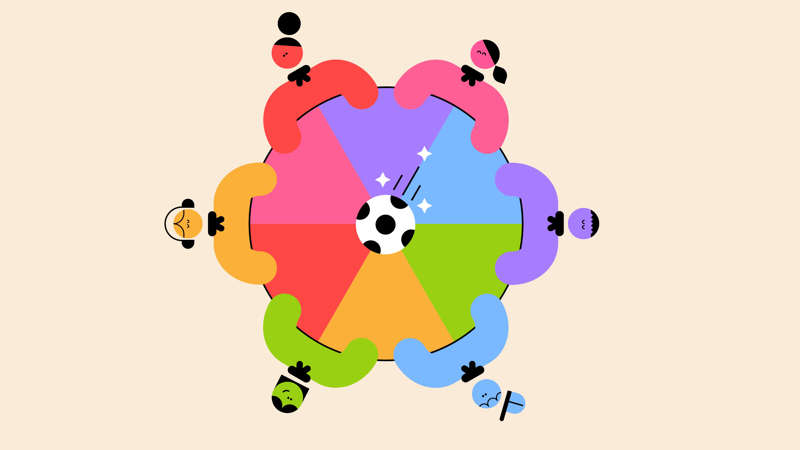
Play 'to me, to you' parachute game
You’ll need
- Footballs
- Parachute (or old sheet or duvet cover)
Before you begin
- Use the safety checklist to help you plan and risk assess your activity. Additional help to carry out your risk assessment, including examples can be found here. Don’t forget to make sure all young people and adults involved in the activity know how to take part safely.
Play the game
- Everyone should stand around the edge of the parachute and hold the handles.
- Explain that everyone should work together to lift the parachute to about chest height, and gently pull it taut.
- Put the ball into the middle of the parachute and say a player’s name.
- Work together to make the ball roll over to the person leading the game has chosen. People can call out instructions to each other if they think it’ll help.
It may take some practice before everyone gets the hang of it—it takes concentration, teamwork, and persistence to get the ball to its destination. You’ll need to put the ball back on if it falls off.
- When the ball reaches the person whose named was called they should call out someone else’s name. The ball must cross the middle of the parachute between each person, so they should choose someone across the parachute from them.
- Roll the ball to the new person.
- Keep playing until everyone’s name has been called, and the ball has visited everyone.
- Everyone could play again—the person leading the game could time everyone, to see how quickly they can get the ball around to everyone.
Reflection
This activity needed you to be a team player. Everyone should go back around the parachute and hold a handle. What would’ve happened if two people tried to play without the rest of the team? What would’ve happened if one or two people stopped helping, or did something totally different to the rest of the team?
This activity also needed you to persevere. You had to keep going, even when it was tricky and the ball didn’t go where you wanted it to. Maybe it even fell off once or twice. Why did you keep trying when things didn’t work? How did it feel when you achieved your goal after you tried again and again?
The person leading the game should put the ball in the middle. If a player agrees with what the person leading the game says, they should lift the parachute; everyone should watch what happens to the ball. In between each statement, everyone should put the parachute back to waist height and the person leading the game should put the ball back into the middle.
Do you agree that: the game was easy right from the start? The game got easier as we got used to working together? The ball didn’t always go where we wanted it to? Everyone helped lead the game? The most important thing was to be fast? It was frustrating when the ball didn’t go where we wanted it to? I tried my best all the way through?
Safety
All activities must be safely managed. You must complete a thorough risk assessment and take appropriate steps to reduce risk. Use the safety checklist to help you plan and risk assess your activity. Always get approval for the activity, and have suitable supervision and an InTouch process.
- Active games
The game area should be free of hazards. Explain the rules of the game clearly and have a clear way to communicate that the game must stop when needed. Take a look at our guidance on running active games safely.
- If you have two parachutes (or old sheets or duvet covers) and enough space you could split into two groups who both play at the same time.
- Turn it into a time trial—you could include penalties for every time the ball falls off.
- A heavier ball (such as a basketball) will be a bit easier to control. Why not experiment with balls of different sizes and weights?
- You could play the game in silence (except calling out the names), or even add another ball into the mix.
- It’s up to you whether people stand up or sit down to play this game—either works. The people leading the activity could stand next to anyone who needs extra help moving the parachute.
- Team games can be trickier for anyone with an additional need (such as autism) that affects communication or social skills. It may be useful to speak to parents and carers to find out about any specific work they’re doing at school or home. You can adjust the size of the team or the group depending on the young person’s needs—this could include working in a pair or a group of three. You can also adjust time periods and quantities.
- Don’t assume everyone will automatically know why teamwork is positive, or what teamwork looks like. You may want to spend some time exploring the benefits of working in a team, for example, teams can often get more done; different people are good at different things so they bring different ideas and skills; and it’s a good way to make friends.
All Scout activities should be inclusive and accessible.
There are lots of other parachute games that encourage people to work in a team—while you have a parachute (or old sheet or duvet) out, you could play another game that counts towards the Beavers or Cubs Teamwork Challenge Award. Use the internet to research other parachute games—you could start by trying these 17 easy parachute games.

